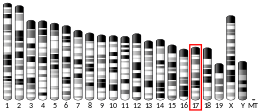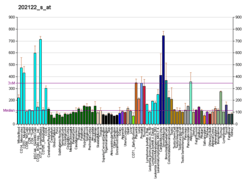Perilipin-3
Mannose-6-phosphate receptor binding protein 1 (M6PRBP1) is a protein which in humans is encoded by the M6PRBP1 gene.[5] Its gene product, as well as the gene itself, is commonly known as TIP47.
| PLIN3 | |||||||||||||||||||||||||
|---|---|---|---|---|---|---|---|---|---|---|---|---|---|---|---|---|---|---|---|---|---|---|---|---|---|
| |||||||||||||||||||||||||
| Identifiers | |||||||||||||||||||||||||
| Aliases | PLIN3, M6PRBP1, PP17, TIP47, perilipin 3 | ||||||||||||||||||||||||
| External IDs | OMIM: 602702 MGI: 1914155 HomoloGene: 4247 GeneCards: PLIN3 | ||||||||||||||||||||||||
| |||||||||||||||||||||||||
| |||||||||||||||||||||||||
| |||||||||||||||||||||||||
| |||||||||||||||||||||||||
| Orthologs | |||||||||||||||||||||||||
| Species | Human | Mouse | |||||||||||||||||||||||
| Entrez | |||||||||||||||||||||||||
| Ensembl | |||||||||||||||||||||||||
| UniProt | |||||||||||||||||||||||||
| RefSeq (mRNA) | |||||||||||||||||||||||||
| RefSeq (protein) | |||||||||||||||||||||||||
| Location (UCSC) | Chr 19: 4.84 – 4.87 Mb | Chr 17: 56.28 – 56.29 Mb | |||||||||||||||||||||||
| PubMed search | [3] | [4] | |||||||||||||||||||||||
| Wikidata | |||||||||||||||||||||||||
| |||||||||||||||||||||||||
Function
Mannose 6-phosphate receptors (MPRs) deliver lysosomal hydrolase from the Golgi to endosomes and then return to the Golgi complex. The protein encoded by this gene interacts with the cytoplasmic domains of both cation-independent and cation-dependent MPRs, and is required for endosome-to-Golgi transport. This protein also binds directly to the GTPase RAB9 (RAB9A), a member of the RAS oncogene family. The interaction with RAB9 has been shown to increase the affinity of this protein for its cargo.[6]
The mannose-6-phosphate receptor-binding properties of TIP47 are disputed,[7] despite the designation of M6PRBP1 as TIP47's gene symbol. TIP47 protein is most commonly described in the scientific literature as a coat protein for lipid droplets.[8]
TIP47 belongs to the peripilin protein family and shares significant homology with the other genes of this family, including perilipin and adipophilin.[9]
Interactions
M6PRBP1 has been shown to interact with both Mannose 6-phosphate receptors.[10][11]
References
- GRCh38: Ensembl release 89: ENSG00000105355 - Ensembl, May 2017
- GRCm38: Ensembl release 89: ENSMUSG00000024197 - Ensembl, May 2017
- "Human PubMed Reference:". National Center for Biotechnology Information, U.S. National Library of Medicine.
- "Mouse PubMed Reference:". National Center for Biotechnology Information, U.S. National Library of Medicine.
- "Entrez Gene: M6PRBP1 mannose-6-phosphate receptor binding protein 1".
- Carroll KS, Hanna J, Simon I, Krise J, Barbero P, Pfeffer SR (May 2001). "Role of Rab9 GTPase in facilitating receptor recruitment by TIP47". Science. 292 (5520): 1373–6. Bibcode:2001Sci...292.1373C. doi:10.1126/science.1056791. PMID 11359012.
- Bulankina AV, Deggerich A, Wenzel D, Mutenda K, Wittmann JG, Rudolph MG, Burger KN, Höning S (May 2009). "TIP47 functions in the biogenesis of lipid droplets" (PDF). J. Cell Biol. 185 (4): 641–55. doi:10.1083/jcb.200812042. PMC 2711566. PMID 19451273.
- Ducharme NA, Bickel PE (March 2008). "Lipid droplets in lipogenesis and lipolysis". Endocrinology. 149 (3): 942–9. doi:10.1210/en.2007-1713. PMID 18202123.
- Brasaemle DL (December 2007). "Thematic review series: adipocyte biology. The perilipin family of structural lipid droplet proteins: stabilization of lipid droplets and control of lipolysis" (PDF). J. Lipid Res. 48 (12): 2547–59. doi:10.1194/jlr.R700014-JLR200. PMID 17878492.
- Díaz, E; Pfeffer S R (May 1998). "TIP47: a cargo selection device for mannose 6-phosphate receptor trafficking". Cell. UNITED STATES. 93 (3): 433–43. doi:10.1016/S0092-8674(00)81171-X. ISSN 0092-8674. PMID 9590177.
- Orsel, J G; Sincock P M; Krise J P; Pfeffer S R (August 2000). "Recognition of the 300-kDa mannose 6-phosphate receptor cytoplasmic domain by 47-kDa tail-interacting protein". Proc. Natl. Acad. Sci. U.S.A. UNITED STATES. 97 (16): 9047–51. Bibcode:2000PNAS...97.9047O. doi:10.1073/pnas.160251397. ISSN 0027-8424. PMC 16819. PMID 10908666.
Further reading
- Bohn H, Kraus W, Winckler W (1983). "Purification and characterization of two new soluble placental tissue proteins (PP13 and PP17)". Oncodev. Biol. Med. 4 (5): 343–50. PMID 6856484.
- Maruyama K, Sugano S (1994). "Oligo-capping: a simple method to replace the cap structure of eukaryotic mRNAs with oligoribonucleotides". Gene. 138 (1–2): 171–4. doi:10.1016/0378-1119(94)90802-8. PMID 8125298.
- Suzuki Y, Yoshitomo-Nakagawa K, Maruyama K, et al. (1997). "Construction and characterization of a full length-enriched and a 5'-end-enriched cDNA library". Gene. 200 (1–2): 149–56. doi:10.1016/S0378-1119(97)00411-3. PMID 9373149.
- Díaz E, Pfeffer SR (1998). "TIP47: a cargo selection device for mannose 6-phosphate receptor trafficking". Cell. 93 (3): 433–43. doi:10.1016/S0092-8674(00)81171-X. PMID 9590177.
- Than NG, Sumegi B, Than GN, et al. (1999). "Cloning and sequence analysis of cDNAs encoding human placental tissue protein 17 (PP17) variants". Eur. J. Biochem. 258 (2): 752–7. doi:10.1046/j.1432-1327.1998.2580752.x. PMID 9874244.
- Than NG, Sumegi B, Than GN, et al. (1999). "Cloning and sequencing of human oncodevelopmental soluble placental tissue protein 17 (PP17): homology with adipophilin and the mouse adipose differentiation-related protein". Tumour Biol. 20 (4): 184–92. doi:10.1159/000030062. PMID 10393528.
- Krise JP, Sincock PM, Orsel JG, Pfeffer SR (2000). "Quantitative analysis of TIP47-receptor cytoplasmic domain interactions: implications for endosome-to-trans Golgi network trafficking". J. Biol. Chem. 275 (33): 25188–93. doi:10.1074/jbc.M001138200. PMID 10829017.
- Orsel JG, Sincock PM, Krise JP, Pfeffer SR (2000). "Recognition of the 300-kDa mannose 6-phosphate receptor cytoplasmic domain by 47-kDa tail-interacting protein". Proc. Natl. Acad. Sci. U.S.A. 97 (16): 9047–51. Bibcode:2000PNAS...97.9047O. doi:10.1073/pnas.160251397. PMC 16819. PMID 10908666.
- Barbero P, Buell E, Zulley S, Pfeffer SR (2001). "TIP47 is not a component of lipid droplets". J. Biol. Chem. 276 (26): 24348–51. doi:10.1074/jbc.M102468200. PMID 11313361.
- Carroll KS, Hanna J, Simon I, et al. (2001). "Role of Rab9 GTPase in facilitating receptor recruitment by TIP47". Science. 292 (5520): 1373–6. Bibcode:2001Sci...292.1373C. doi:10.1126/science.1056791. PMID 11359012.
- Hanna J, Carroll K, Pfeffer SR (2002). "Identification of residues in TIP47 essential for Rab9 binding". Proc. Natl. Acad. Sci. U.S.A. 99 (11): 7450–4. Bibcode:2002PNAS...99.7450H. doi:10.1073/pnas.112198799. PMC 124251. PMID 12032303.
- Miura S, Gan JW, Brzostowski J, et al. (2002). "Functional conservation for lipid storage droplet association among Perilipin, ADRP, and TIP47 (PAT)-related proteins in mammals, Drosophila, and Dictyostelium". J. Biol. Chem. 277 (35): 32253–7. doi:10.1074/jbc.M204410200. PMID 12077142.
- Strausberg RL, Feingold EA, Grouse LH, et al. (2003). "Generation and initial analysis of more than 15,000 full-length human and mouse cDNA sequences". Proc. Natl. Acad. Sci. U.S.A. 99 (26): 16899–903. Bibcode:2002PNAS...9916899M. doi:10.1073/pnas.242603899. PMC 139241. PMID 12477932.
- Sincock PM, Ganley IG, Krise JP, et al. (2003). "Self-assembly is important for TIP47 function in mannose 6-phosphate receptor transport". Traffic. 4 (1): 18–25. doi:10.1034/j.1600-0854.2003.40104.x. PMID 12535272.
- Than NG, Sumegi B, Bellyei S, et al. (2003). "Lipid droplet and milk lipid globule membrane associated placental protein 17b (PP17b) is involved in apoptotic and differentiation processes of human epithelial cervical carcinoma cells". Eur. J. Biochem. 270 (6): 1176–88. doi:10.1046/j.1432-1033.2003.03475.x. PMID 12631276.
- Nair P, Schaub BE, Rohrer J (2003). "Characterization of the endosomal sorting signal of the cation-dependent mannose 6-phosphate receptor". J. Biol. Chem. 278 (27): 24753–8. doi:10.1074/jbc.M300174200. PMID 12697764.
- Blot G, Janvier K, Le Panse S, et al. (2003). "Targeting of the human immunodeficiency virus type 1 envelope to the trans-Golgi network through binding to TIP47 is required for env incorporation into virions and infectivity". J. Virol. 77 (12): 6931–45. doi:10.1128/JVI.77.12.6931-6945.2003. PMC 156179. PMID 12768012.
- Ota T, Suzuki Y, Nishikawa T, et al. (2004). "Complete sequencing and characterization of 21,243 full-length human cDNAs". Nat. Genet. 36 (1): 40–5. doi:10.1038/ng1285. PMID 14702039.
- Colland F, Jacq X, Trouplin V, et al. (2004). "Functional proteomics mapping of a human signaling pathway". Genome Res. 14 (7): 1324–32. doi:10.1101/gr.2334104. PMC 442148. PMID 15231748.
- Ganley IG, Carroll K, Bittova L, Pfeffer S (2005). "Rab9 GTPase regulates late endosome size and requires effector interaction for its stability". Mol. Biol. Cell. 15 (12): 5420–30. doi:10.1091/mbc.E04-08-0747. PMC 532021. PMID 15456905.
External links
- PLIN3 human gene location in the UCSC Genome Browser.
- PLIN3 human gene details in the UCSC Genome Browser.




